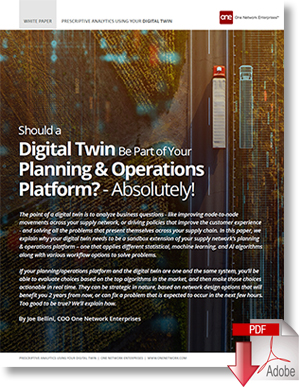Should a Digital Twin Be Part of Your Supply Chain Planning & Operations Platform?

Absolutely it should! The point of a digital twin is to analyze business questions - like improving node-to-node movements across your supply network, or driving policies that improve the customer experience - and solving all the problems that present themselves across your supply chain.
Planning Operations Platform and the Digital Twin
In this article (and white paper), we explain why your digital twin needs to be a sandbox extension of your supply network’s planning & operations platform – one that applies different statistical, machine learning, and AI algorithms along with various workflow options to solve problems.
If your planning/operations platform and the digital twin are one and the same system, you’ll be able to evaluate choices based on the top algorithms in the market, and then make those choices actionable in real-time.
They can be strategic in nature, based on network design options that will benefit you 2 years from now, or can fix a problem that is expected to occur in the next few hours.
Too good to be true? We’ll explain how.
Prescriptive Analytics Using Your Digital Twin
My experience with digital twins goes back to my engineering days at both General Electric and General Motors.
Whether it was jet engines or my more complex nuclear missile guidance system, I needed to create digital twins to test variables around heat transfer along with validating that the manufactured items actually met the complex design geometries.
In this sense, my digital twins were digital replicas of manufactured components to be used for analysis and prediction.
We also applied prediction within our digital twin representations for the six-axis robots we utilized to manufacture the guidance systems in order to schedule maintenance prior to losing tolerance when manufacturing our gimbals.
In this sense, my digital twin was related to a process, and the predictive models designed to improve that process.
At One Network Enterprises, we have now applied similar digital twin techniques to supply chain network planning, operations, and execution.
Today, digital twin and digitization, in general, have become what I call “duffel bag terms”.
You can define it in many different ways, and it all loosely fits in the duffel bag. A similar situation exists around AI as a duffel bag term.
The reason I created my original digital twins was to generate a useful result that I couldn’t get with the actual units unless I was willing to shoot them into space or sometimes even blow them up under stress.
The benefits of these digital twins were twofold: first finding design issues that would lead to failures so I could correct the designs before any failures occurred; and second, evaluating design changes related to troublesome variables/ measures or for actual failures themselves.
Much of my work was done with CAD/CAM/CAE/CIM along with heat transfer differential analysis.
Digital Twins Solve Supply Chain Network Problems
I have found that extending digital twin problem-solving techniques to a supply chain network requires that we first must model the entire end-to-end supply chain network to form the foundation for our analysis.
Since the opportunities or problems that will be exposed by our analysis could manifest themselves over strategic, tactical, or operational timeframes, the foundation should be seamless across time horizons.
It should offer services, algorithms, and analysis that run across the network representation in real-time, whether we are solving problems predicted to happen in six months, or during a delivery scheduled for later this afternoon.
The implication here is that the correct foundation for a digital twin is an execution platform whose item-level modeling and representation can scale in detail from execution all the way forward into longer-term sales and operations planning.
This digital twin is not a simulation.
A Digital Twin is Not a Separate System
Planning software vendors often try to provide digital twin capabilities by using simulation techniques or even try to import operating data from the ERP system using some kind of rapid response, but this method falls far short in its ability to generate high-value results.
If a vendor starts talking about the right level of resolution based on differing forecast horizons, that means the foundation/platform cannot scale properly to solve the problem.
Some vendors even talk about using approximations for longer-term time horizons which is nothing but an average and will return average results.
“There is nothing better than having a digital twin capability that is an extension of your operating platform. You can evaluate choices based on the top algorithms in the market and then make those choices actionable in real-time.”
The real problem is that those architectures are antiquated and not really designed for digital twin type problem-solving.
Their problem-solving algorithms, if modeled in detail, would run seemingly forever due to their architectural limitations.
The in-memory approach we took back in the early 90’s has been surpassed in performance, scalability, and reliability by newer real-time supply network platforms.
An extension of these limitations leads some folks to talk about “concurrent planning”.
The fact that there is any demand in the market for concurrent planning means that somehow users have been convinced they need two different software representations or applications for operational and tactical planning and that the two should be interoperable.
This is ridiculous. That’s because modern platforms can certainly scale detail from operational to tactical to strategic.
Changes in time, or temporal changes, are nothing but state changes related to something like an order.
The order may start life 2 years out as part of Sales & Operations Planning (S&OP), and then change state to a forecast order at 12 months, then a planned order at 6 months, then a committed order at 1 month, then a shipped order at 1 week, then an in-transit order at 4 hours, and then a received order at time zero, then an authorized-to pay invoice order at the time minus 1 day.
On a real-time supply chain network, these are just state changes across a seamless platform where all levels of detail are available in all time horizons.
When planning, operating and executing in this type of platform environment, the entire network becomes more resilient, more responsive, and the likelihood of the plan being executed without major problems is much higher.
Your Supply Chain Network Platform Should Be Your Digital Twin Environment
An end-to-end real-time supply network platform/foundation enables the ability to test out new supply chain policies, network resiliency, the feasibility of strategic or tactical plans, activate alternate parts or suppliers, modify modes of transportation, or even add additional shifts at a plant.
In this sense, it is the platform itself that also serves to enable the digital twin.
You don’t need to configure and support a separate reference model.
Your digital twin is a sandbox extension of your supply network platform that applies different statistical, machine learning, and AI algorithms along with various workflow options to solve different types of problems.
The planning & operations platform and digital twins are one and the same system.
Download the Paper: “Should a Digital Twin Be Part of Your Planning & Operations Platform? - Absolutely!” to continue reading this educational and informative article.
WEBCAST How to Optimize Your Supply Chain with a Digital Twin
Date: Thursday, July 16, 2020 | Time: 12:00 PM EDT / 9:00 AM PDT
Apply prescriptive analytics to help you deliver the highest possible service levels at the lowest cost.
The point of a digital twin is to analyze business questions - like improving node-to-node movements across your supply network, or driving policies that improve the customer experience and solve all the problems that present themselves across your supply network.
In this Webcast, we’ll explain why your digital twin needs to be a sandbox extension of your planning and operations platform – one that applies different statistical, machine learning, and AI algorithms along with various workflow options to solve problems.
If your planning/operations platform and the digital twin are one and the same system, you’ll be able to evaluate choices based on the top algorithms in the market, and then make those choices actionable in real-time. They can be strategic in nature, based on network design options that will benefit you two years from now, or can fix a problem that is expected to occur in the next few hours. Sound too good to be true? We’ll explain how.
One Network Enterprises is a leader in supply chain planning, execution, and digitization, so join COO Joe Bellini for insights on how to optimize performance, gain resilience, manage costs through thick and thin, and protect revenue growth with a digital twin strategy.

Article Topics
One Network Enterprises News & Resources
Blue Yonder announces an agreement to acquire One Network Enterprises for $839 million Blue Yonder Acquires One Network Enterprises for $839M Companies Need to Develop New Innovative Approaches to Supply Chain Design How to Improve Cost of Goods Sold Horizontally Across the Supply Chain How the Global Pandemic Accelerated Supply Chain Visibility, Digitalization, and Automation AI and Data, the Future of Supply Chain Management AI and Supply Chain Problem Solving More One Network EnterprisesLatest in Supply Chain
How Supply Chains Are Solving Severe Workplace Shortages SAP Unveils New AI-Driven Supply Chain Innovations How Much Extra Will Consumers Pay for Sustainable Packaging? FedEx Announces Plans to Shut Down Four Facilities U.S. Manufacturing is Growing but Employment Not Keeping Pace The Two Most Important Factors in Last-Mile Delivery Most Companies Unprepared For Supply Chain Emergency More Supply Chain















